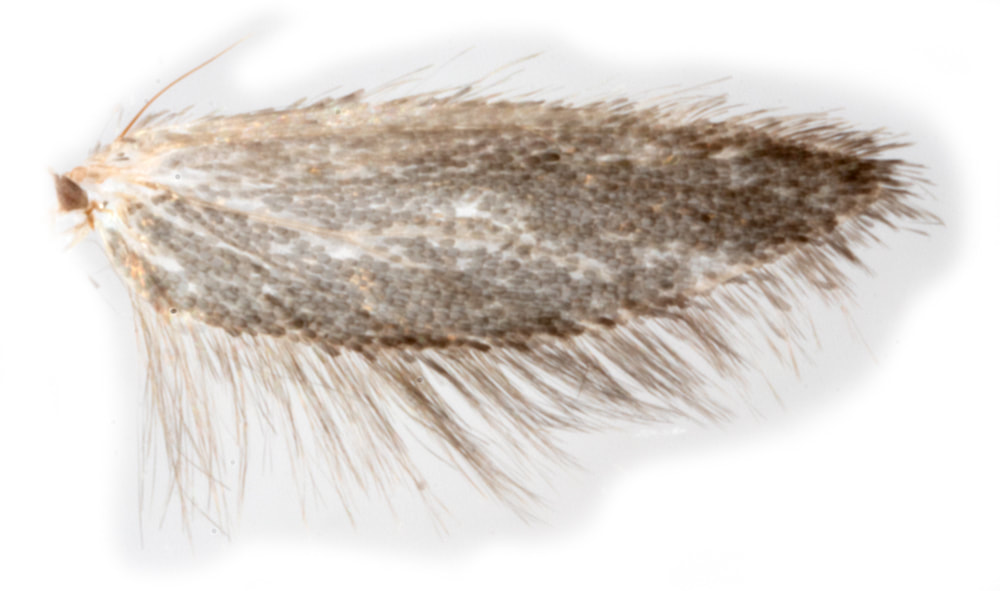12.038 Monopis obviella (Yellow-backed Detritus Moth)
ws:10-13mm; May-Oct; locally common in S.England, less common further North.
ID: M.crocicapitella is very similar to M.obviella. According to MBGBI2 they can be separated by the following features:
1) Dorsal streak pale yellow in obviella, ochreus in crocicapitella.
2) Pale irroration limited to whitish scales near costa in obviella, more generalised especially in the apical region in crocicapitella.
3) Hindwing dark fuscous in obviella, pale grey in crocicapitella.
4) Valvae of male genitalia shorter and broader with a more rounded apex in obviella, longer and narrower with a more angular apex in crocicapitella. length/breadth of valva ~2.1-2.3 in obviella 2.8-2.9 in crocicapitella.
5) Aedeagus blob-ended at apex in obviella, more tapered in crocicapitella.
6) Female genitalia: according to Moth Dissection with "band of regular cornuti" in bursa copulatrix of obviella, and "a few large cornuti, others irregular and scattered" in crocicapitella. However, I think that "cornuti" should refer to thorns in the male genitalia; "signa" being the more usual term for those in the female genitalia; and the images presented at Moth Dissection are not entirely convincing when it comes to this stated difference between the species. On the M.crocicapitella page the bursa copulatrix is not shown and the sclerotised antrum is of even diameter and about 4x longer than wide. On the M.obviella page, there is one image showing the whole genitalia, labelled as M.obviella, with an inset purporting to show the difference in the signa between the two species - in this image the antrum looks the same as in the M.crocicapitella image. On the M.obviella page there is a second image, which does not show the bursa but does show the sclerotised antrum to be much shorter and quite different from that in the other image labelled as M.obviella.
See Monopis for more detail
1) Dorsal streak pale yellow in obviella, ochreus in crocicapitella.
2) Pale irroration limited to whitish scales near costa in obviella, more generalised especially in the apical region in crocicapitella.
3) Hindwing dark fuscous in obviella, pale grey in crocicapitella.
4) Valvae of male genitalia shorter and broader with a more rounded apex in obviella, longer and narrower with a more angular apex in crocicapitella. length/breadth of valva ~2.1-2.3 in obviella 2.8-2.9 in crocicapitella.
5) Aedeagus blob-ended at apex in obviella, more tapered in crocicapitella.
6) Female genitalia: according to Moth Dissection with "band of regular cornuti" in bursa copulatrix of obviella, and "a few large cornuti, others irregular and scattered" in crocicapitella. However, I think that "cornuti" should refer to thorns in the male genitalia; "signa" being the more usual term for those in the female genitalia; and the images presented at Moth Dissection are not entirely convincing when it comes to this stated difference between the species. On the M.crocicapitella page the bursa copulatrix is not shown and the sclerotised antrum is of even diameter and about 4x longer than wide. On the M.obviella page, there is one image showing the whole genitalia, labelled as M.obviella, with an inset purporting to show the difference in the signa between the two species - in this image the antrum looks the same as in the M.crocicapitella image. On the M.obviella page there is a second image, which does not show the bursa but does show the sclerotised antrum to be much shorter and quite different from that in the other image labelled as M.obviella.
See Monopis for more detail
§1 Arne, Dorset; 05/07/2016; male; fw 5.6mm
§2 Foulness, Essex; 15/08/2020; male; fw 4.0mm
All images © Chris Lewis
§2 Foulness, Essex; 15/08/2020; male; fw 4.0mm
All images © Chris Lewis
Page published 29/10/2013 (§1) | §2 added 29/11/2016 | §3 added 20/11/2018 | §1 and §3 removed (misidentification) 27/11/2018 |
§2 renumbered as §1 27/11/2018 | new §2 added 27/08/2020
§2 renumbered as §1 27/11/2018 | new §2 added 27/08/2020








